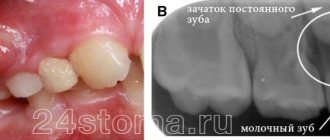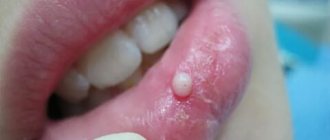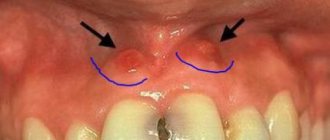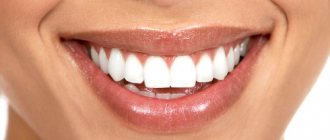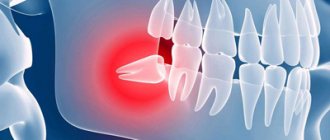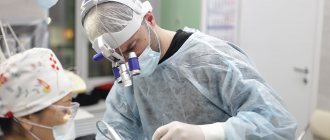Quite often, parents may notice a soft bump that appears on their child’s gum when pressed. What could be the reasons for this phenomenon?
- inflammation of the roots (both baby teeth and molars, permanent ones);
- the beginning of tooth eruption.
Why does an abscess occur?
There can be many reasons for the formation of a lump (fistula, swelling), but the most common of them is undetected or ignored caries. Not all children maintain oral hygiene and eat properly, and not all parents carefully control this, which causes caries to appear on one or several teeth at once.
If caries is not treated, it will develop into pulpitis, extending beyond the tooth area and affecting the upper part of the root. As a rule, a lump appears just near the tooth whose root is inflamed. Typically, a lump can be noticed near a tooth with caries or with a filling that was placed long ago or poorly; Another common reason for its appearance is an injury received from a strong blow or an accidental fall, which can trigger the onset of the inflammatory process.
Stages of development of an abscess:
- As a result of caries, the infection penetrates into the pulp, affecting the root tip.
- Pus begins to form near the top of the root.
- Purulent formations fall under the mucous membrane of the gums.
- A cyst appears, looking like a small lump from the outside.
The most important symptom of an abscess is a soft and painful swelling, even with slight pressure.
Sometimes, due to an excess of pus, the lump may burst under pressure, and then a fistula appears - a small hole in the gum, which is connected with the source of inflammation located in the upper region of the root. A feature of the fistula is the constant release of purulent formations.
If inflammation decreases for some reason, the fistula may close on its own. However, when the child’s immunity decreases and the inflammatory process begins again, accompanied by pus formation, the appearance of a fistula will not be long in coming.
Types of epulis
Depending on the nature of the pathological process, epulis on the gums is divided into three main types.
- Fibrous. The gum tumor differs in density. Its base is coarse fiber fabric. The tumor grows slowly and asymptomatically.
- Angiomatous. Epulis angiomatous consist of epithelial cells and a large number of blood vessels. The tumor is localized mainly in the molar area. Due to the many blood vessels, even with a slight impact on the tumor, bleeding occurs. On palpation, the lump is soft and painful.
- Giant cell. The tumor formation can be large. Giant cell epulis affects the position of teeth, displacing them. Pain is not typical for this species, but bleeding is possible due to mechanical damage.
The development of giant cell epulis on the gum poses the greatest risk, since the likelihood of the tumor becoming malignant is much higher than with other forms of the disease.
How to treat an abscess on the gum?
If an abscess or fistula appears, then you should not expect that the situation will resolve on its own: you need to make an appointment with a dentist. Treatment of an abscess on a baby tooth and a molar one will be different.
The appearance of an abscess on a baby tooth indicates periodontal inflammation. Such teeth must be removed, since the inflammatory process in the upper part of the root, accompanied by the formation of pus, may well spoil the molar, which will soon erupt in place of the milk tooth. This happens because the roots of temporary teeth are located next to the rudiments of molars. Bad bacteria and infection can also enter the lymph nodes under the jaw, causing them to become inflamed. The occurrence of a fistula means that pus will constantly seep into the mouth, which can cause the development of tonsillitis, since the tonsils will become infected. Various colds in a child are a direct consequence of an abscess on a tooth. Also, do not forget that toxins formed in the area of inflammation will definitely enter the bloodstream: this can result in allergic reactions, asthma and other serious general somatic diseases.
If we are talking about an abscess on a molar, then ordinary treatment is required for adults (provided that the tooth is not fundamentally damaged and can still be saved from removal).
Having discovered an abscess in a child, you should not try to cure it on your own. You can easily find a lot of advice on the Internet on how to relieve inflammation, but no amount of rinsing or even taking powerful antibiotics can eliminate the inflammatory focus located at the root of the tooth. Moreover, it is useless to hope that the tooth ache will stop. A bursting lump (this often happens) indicates only a short respite, during which, meanwhile, bacteria will still continue to enter the bloodstream and spread throughout the body. This situation can turn into a serious problem if the child has diseases of the respiratory system, heart and other internal organs.
Often, dentists suggest leaving teeth near which the inflammatory process is occurring, persuading the parents of a young patient to carry out the silvering procedure. The arguments for refusing removal can be very compelling: possible problems with diction and pain during the removal operation. However, such dentists neglect the information contained in every textbook on dentistry, which clearly states that a baby tooth with a purulent focus must be removed. Silvering will only complicate the situation, and an unresolved inflammatory process can lead to asthma, tonsillitis and even diabetes: in comparison with these diseases, temporary problems with diction will seem like sheer nonsense.
But the formation of an abscess can be prevented, and this is not difficult to do - just teach the child to maintain oral hygiene. At an early age, a child cannot be adequately responsible for his actions, including those related to the care of the oral cavity, teeth and gums, so responsibility for the procedure lies entirely with his parents, who must control how and when the child brushes his gums and teeth . It is the parents who should buy the most effective baby toothpaste that guarantees maximum protection against caries.
Treatment of inflammation
Removal of a lump with pus on a child’s gum should be started immediately. Only a dentist can help the baby.
IMPORTANT! Self-medication, as well as piercing and squeezing are strictly prohibited! Such an intervention will lead to serious complications.
When an abscess forms over a baby's baby tooth, the doctor most often removes it. Such measures are necessary to exclude the possibility of destruction of the rudiments of the root. If a child has a lump on his gum next to a permanent tooth, treatment begins with a thorough examination. Sometimes the dentist will send you for an x-ray to assess the extent of the damage. Removal of a permanent tooth is carried out in extreme cases.
A lump on an area of the gum where there is no tooth yet: what to do in this case?
A couple of weeks before the tooth erupts, a cyst may appear on the gum, looking like a lump filled with a clear or bluish liquid. Such bumps are by no means common: dentists do not consider such formations to be a pathology requiring treatment. In addition, such formations on the gums in no way indicate an inflammatory process.
According to statistics, a small percentage of children are affected by the appearance of such a cyst. The child may not even suspect that he has a lump in his mouth, because if he touches it, there is no pain. However, a dental examination is still necessary, because the inflammatory process may still begin, in which case intervention will be required. The presence of inflammation is indicated by such signs as increased body temperature, pain when touching the lump, and swelling of the mucous membrane.
Most parents do not like the fact that their child has a lump in his mouth: in this case, you can ask the dentist to make an incision under anesthesia, as a result of which the fluid inside the cyst will come out. As a rule, when part of the cyst is removed, the crown of the tooth about to erupt is visible.
Swollen gums in a child
If your child has become capricious, lethargic, has a fever and complains of pain in the mouth, it may be gumboil. The scientific name for this phenomenon is periostitis. The disease is associated with inflammation of the tissues of the periosteum of the alveolar processes. It is caused by a decrease in immunity and the proliferation of pathogenic bacteria with the formation of pus.
Symptoms:
- weakness, painful condition;
- increased body temperature;
- possible refusal to eat;
- redness of the gums in one place, swelling;
- swelling of the cheeks/lips, asymmetrical face in a child.
What to do? Take your child to the dentist as soon as possible.
In this case, you don’t need to make an appointment in advance - you will see a doctor with the wording “for acute pain.” The specialist will open the tooth and rinse the canal, and in the future you will have to make sure that the child rinses his mouth with an antiseptic solution. It is also possible for a doctor to prescribe antibiotics.
The dentist will also recommend making an appointment with him after the inflammation has subsided. It is necessary to put a filling on the tooth, since the open canal will periodically become inflamed, and it is undesirable to leave it like that.
How to help a child at home with suppuration?
If suppuration and the formation of a lump on the gum appear, it is recommended to contact a dentist as soon as possible, but, unfortunately, for various reasons this is not always possible.
If an adult can endure pain (although, of course, situations are different), then it is much more difficult for a child to endure painful sensations, and it is not easy for parents to watch their child suffer. There are ways to alleviate the baby's condition. Naturally, they will not replace full-fledged treatment, so you can resort to them only in situations where going to the doctor is impossible right now.
These include:
- take as much warm liquid as possible, which reduces intoxication of the body;
- eat liquid food (moderately warm, but not hot!), as it injures already damaged gums;
- If the pain becomes severe, you can use painkillers. For example, Nurofen or Paracetamol - the exact dosage depends on the age of the child, so before use you should carefully read the instructions for the drug;
- to reduce swelling, you can resort to cold - any frozen product from the freezer compartment of the refrigerator is wrapped in a soft cloth and applied to the cheek;
- use rinsing solutions that temporarily relieve pain - chamomile decoction or the drug chlorhexidine, which reduces irritation.
If the ball in your mouth does not cause discomfort
The color of the bubble will help the doctor make a diagnosis. A white lump on the gum indicates the presence of exostosis or purulent exudate. A red or bloody ball indicates the development of inflammation. If the growth matches the shade of the tissue, it is the initial stage of epulis, flux, or a malignant tumor. When the tumor does not hurt, this indicates the presence of one of the pathologies:
A fistula is a white ball on soft tissues that appears under or on a tooth. There is a hole on the surface for the release of pus. If, when pressed, suppuration flows out of the bladder, the patient does not feel pain. If the hole is closed with pus or bloody clots, the patient will experience discomfort with any impact.
A fistula is often formed due to advanced periodontitis, accompanied by periodontal hyperplasia. Overgrown tissue is good soil for the proliferation of microorganisms. In this case, the patient urgently needs treatment for periodontitis.
In the absence of therapy, the fistula enters a chronic stage, which can only be eliminated through surgical treatment. The progression of the disease must not be allowed, otherwise you may lose healthy molars.
Hematoma is a round lump on the inner surface of the cheek. Sometimes it occurs in the form of a dark bluish swelling on top of the gums. Blood accumulates in or around the root of the molar. The mucous membrane grows, the patient experiences discomfort and cannot completely close the jaw. The main reasons: consequences of filling or tooth extraction, gum damage, poor blood clotting.
Hematomas are generally not dangerous. Processes take place in the body through which soft tissues are cleared of bloody clots. After some time, the bubble disappears, but if the seal remains, you need to visit a dental clinic.
Exostosis is a hard blister that is an abnormality in which the bones protrude and protrude from the jaw. Gradually, the lump increases in volume, which causes discomfort and pain. Exostosis can be provoked by various reasons:
- jaw damage;
- heredity;
- congenital disorders;
- tissue diseases after molar removal.
An examination by a dentist or an x-ray will help detect the disease. The formation will need to be removed if the development of a malignant tumor is suspected.
Epulis is a pedunculated bubble in the form of a mushroom-shaped growth on the periodontium. The tumor may be the same color as the gums or red. The reasons causing the development of pathology include:
- improper filling of the molar or too large a filling;
- dental plaque, stone;
- jaw damage;
- malocclusion;
- hormonal imbalance;
- poor prosthetic material or incorrect prosthetics.
The symptoms of epulis resemble gingivitis; for diagnosis, the dentist prescribes radiography and histology to the patient. With their help, the degree of destruction of bone tissue at the site of the epulis lesion is determined. Mostly, pathology occurs in children during the growth of primary molars and in women.
Papilloma or fibroma is a bubble on the gum, sometimes a benign formation that does not pose a threat to the health or life of the patient. They are formed in people of different genders and ages. Predisposing factors to the appearance of a lump can be: damage to the mucosa, stress, systemic pathologies, heredity.
Papilloma is an enlargement of the papillary layer of skin. The bubble grows gradually, but with reduced immunity, systemic pathology, or stress, growth accelerates, but without turning into a malignant tumor. A papilloma neoplasm looks like a smooth, soft lump on the mucous membrane of a white or pink shade on a thin stalk.
Papilloma often does not create any discomfort. But after some time it may increase in size. You should consult a dentist and get tested.
Preventive measures to prevent the formation of lumps on the gums
To reduce the likelihood of an abscess to a minimum, a child from childhood should be taught to carefully observe oral hygiene.
The list of the most effective measures includes:
- Brushing your child's teeth twice a day. First, parents should brush their child’s teeth themselves, showing how to do it correctly, gradually giving the child more independence in this matter;
- rinsing your mouth after every meal;
- minimizing sweets in the diet - it is important to ensure that the child keeps caramel and candies in his mouth as little as possible;
- Do not introduce your child to chewing gum (the product is especially harmful if it contains sugar).
Why does an abscess form?
Among the reasons for the appearance of ulcers may be poor oral hygiene, weak immunity, mechanical and thermal injuries, and gum disease.
Baby teeth are more often exposed to various infections, and caries spreads much faster in them. In just a few months, a cavity can form that reaches the nerve. If this is not treated, the bacteria enter the dental nerve and then affect the bone. Here they multiply, dissolve the bone and thus form pus, which can be released into the oral cavity.
Otherwise, it accumulates and appears under the gum, which swells and takes on the appearance of a lump. Sometimes it bursts, but then appears again. The danger of this process is that in any case there is an infection in the body, and the pus can damage the growing permanent tooth.
Also, the formation of an abscess can occur due to the following factors:
- periodontonitis is an inflammation of the connective tissue that is located between the cementum of the tooth and the alveolus. The process can begin due to a virus, bacteria, hypothermia or injury;
- single-gene osteomyelitis - damage to the bone and surrounding tissues due to infection in the dental canal. This is possible due to poor quality dental treatment;
- dental cyst is a formation in the bone tissue of the jaw that is filled with fluid. In this case, an abscess is formed if the cyst becomes inflamed with the formation of pus, which begins to come out;
- odontogenic sinusitis - inflammation of the mucous membrane of the maxillary sinus. Infection can occur due to untimely dental treatment or dental errors.
It is also important to treat caries in the early stages to prevent the development of pulpitis - inflammation of the pulp, which consists of various vessels and nerves that provide important functions of the tooth.
Treatment with gels and ointments
The pharmaceutical market offers a large number of dental preparations in the form of anti-inflammatory gels and ointments. They help relieve inflammation, improve the condition of the gums and strengthen the blood vessels located in the oral cavity. Many of them contain substances from the group of local analgesics and can not only cure the inflammatory process, but also reduce the intensity of pain. Before use, you must carefully read the instructions, since some medications in this group cannot be used until a certain age is reached (for example, Metrogyl Denta based on chlorhexidine and metronidazole is approved for use in children over 6 years of age).
"Metrogil Denta"
The following medications can be used to treat abscesses and inflammatory processes in children:
- "Holisal";
- "Asepta";
- "Dentinox";
- "Kamistad".
"Asepta"
They must be applied to the affected surface 1 to 3 times a day - depending on the drug chosen. The course of treatment usually ranges from 5 to 7-10 days.
- How to store urine for analysis before submitting it to the laboratory for a child and an adult
Important! The use of topical drugs will be effective only in cases where there are no signs of a purulent-infectious process. If pus has already begun to accumulate in the cavity, only opening the formation and installing drainage can help.
Treatment of baby tooth gum abscess
Should I give my child antibiotics?
The doctor may prescribe your child broad-spectrum antibacterial drugs to relieve inflammation and reduce the risk of complications after the procedure. Antibiotics help cope with pathogenic flora and prevent secondary infection of tissues, but they can only be used as prescribed by a doctor in the recommended dosage.
How to treat an abscess on the gum
Penicillins are becoming the drugs of choice for the prevention of complications in children. They are available in tablets and capsules, and young children can be given the medicine in suspension form. Commonly prescribed drugs with high effectiveness and minimal side effects include:
- "Augmentin";
- "Amoxiclav";
- "Amosin";
- "Flemoxin".
"Augmentin"
Children over 10 years of age may be prescribed Metronidazole in a dosage appropriate for their age. In case of severe inflammation or complicated pathology, doctors recommend taking potent antibacterial drugs from the group of cephalosporins or macrolides (Zinnat, Sumamed, Ciprofloxacin). The course of treatment depends on the chosen drug and the severity of the inflammatory process and can range from 3 to 10 days.
"Sumamed"
Note! Taking antibiotics of any group must be combined with the use of products that include probiotic cultures, lactobacilli, prebiotics and bifidobacteria. For young children, it is best to give Bifiform, Linex or Bifidumbacterin (provided there is no lactase deficiency). For children over 7 years old, Normobakt and Acipol are suitable.
"Bifiform"
